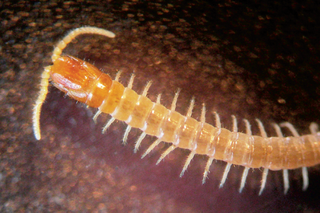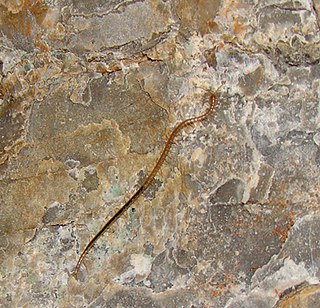Pachymerium is a genus of centipedes in the family Geophilidae found mainly in the west Palearctic region and in south Africa. Centipedes in this genus feature an elongate head, scattered coxal pores, and sternal pores in a pair of anterior groups and a posterior transverse band; the forcipular coxosternite is broad, and the ultimate article of the forcipule has a prominent basal denticle.

The Geophilidae are a polyphyletic, cosmopolitan family of soil centipedes in the superfamily Geophiloidea containing the mostly defunct clades Aphilodontidae, Dignathodontidae, Linotaeniidae, Chilenophilinae, and Macronicophilidae. These centipedes are found almost worldwide.

Bothropolys is a genus of centipedes in the family Lithobiidae.

Strigamia is a genus of soil centipedes in the family Linotaeniidae found in temperate parts of the Holarctic region. Members of this family can be identified by their anteriorly tapering bodies, the extra claw on the forcipules, scattered coxal pores, and the distinctly swollen ultimate legs of the males. The generic name is from Latin striga, "strip," referring to its strip of bristles.

Tygarrup is a genus of centipedes in the family Mecistocephalidae, found mainly in southeast Asia and from the Seychelles to Hawaii. Although species in this genus can have either 43 or 45 leg-bearing segments, most of these species have 45 leg pairs. An undescribed Tygarrup species found in the Andaman Islands has 43 leg pairs. Centipedes in this genus are sometimes melanised in patches, and sternal glands are present the males of most species. These centipedes range from 2 cm to 6 cm in length. Tygarrup javanicus is one of the smallest of the mecistocephalid species and has become an invasive in greenhouses in Europe.
Arrup is a genus of centipedes in the family Mecistocephalidae, native to Europe and Asia as far as Japan. Centipedes in this genus feature small telopodites on the second maxillae, the head and forcipular segment are elongate, the clypeus is almost completely areolate, and the poison glands in adult males are often deep inside the forcipules. These centipedes range from 1 cm to 5 cm in length. All species in this genus have 41 leg-bearing segments. Most are soil-dwellers but Arrup akiyoshiensis is a troglobiont.
Dignathodontidae is a monophyletic clade of soil centipedes in the family Geophilidae found in the Mediterranean region, extending to Macaronesia, Caucasus, and western and central Europe. The clade is characterized by a gradually anteriorly tapered body, a short head with non-attenuated antennae, and a poorly sclerotized labrum with tubercles. The number of legs in this clade varies within as well as among species and ranges from 43 pairs to 153 pairs of legs. Species in this clade tend to have more leg-bearing segments and greater intraspecific variability in this number than generally found in the family Geophilidae.
Acanthogeophilus spiniger is a species of soil centipede in the family Geophilidae found in Northwest Africa. The original description of this species is based on a male specimen measuring 27 mm in length with 71 pairs of legs. It was first assigned to the genus Geophilus, but was moved to Acanthogeophilus in 1999 by Foddai and Minelli. Like other species in its genus, it is characterized by incomplete chitin lines, complete coxopleural sutures, stout legs, and a claw-like pretarsus.
Geophilus impressus is a species of soil centipede in the family Geophilidae found all over Europe, and has also been recorded in North Africa. It lives frequently in endogean habitats; in Sardinia it's found mostly in Quercus ilex woods, but also in Mediterranean shrub, open habitats, and maquis. It lives anywhere from sea level to 1700 meters above it, sometimes in caves.
Geophilus bobolianus is a species of soil centipede in the family Geophilidae found in France and Italy. This species has 45 to 51 pairs of legs. It was originally classified as a subspecies of G. longicornis identified by its lack of anterior sternal pores.
Geophilus bosniensis is a species of soil centipede in the family Geophilidae endemic to Bosnia and Herzegovina. It grows up to 30 millimeters and has 75 leg pairs, as well as sternites unseparated in the median but with a suture line, and sternal pore areas in the trunk segments only. Overall, the identity and phyletic position of this centipede are uncertain.
Geophilus claremontus is a species of soil centipede in the family Geophilidae found in Claremont, California, after which it was named. It was incorrectly placed in the genus Brachygeophilus in 1929 by Attems, most likely based on the lack of sternal pores.

Cryptops sometimes known as cave centipedes, is a centipede genus in the family Cryptopidae; species records have a world-wide distribution.

Ribautia is a genus of centipedes in the family Geophilidae. This genus was described by French myriapodologist Henry Wilfred Brolemann in 1909. Centipedes in this genus are found in South America, tropical Africa, Madagascar, the Arabian peninsula, Australia, New Zealand, and Melanesia.
Tuoba is a genus of 17 species of centipedes, in the family Geophilidae. This genus was described by American biologist Ralph Vary Chamberlin in 1920. These centipedes are found in coastal regions and islands in the Mediterranean and in the Atlantic, Pacific, and Indian oceans.
Mecistocephalus is a genus of centipedes in the family Mecistocephalidae. It was described by British entomologist George Newport in 1843.
Schendyla is a genus of centipedes in the family Schendylidae found in the west Palearctic region. This genus was described by Danish entomologists Vilhelm Bergsøe and Frederik Vilhelm August Meinert in 1866. Centipedes in this genus feature only a few spines on the claws of the second maxillae, two pores on each coxopleuron, and ultimate legs without claws.

Lamyctes is a genus of centipedes in the family Henicopidae. It was described by Danish entomologist Frederik Vilhelm August Meinert in 1868.
Pectiniunguis is a genus of centipedes in the family Schendylidae. It was described by American naturalist Charles Harvey Bollman in 1889. Centipedes in this genus feature second maxillae with claws fringed by two rows of filaments, transversally elliptical sternal pore-fields on almost all trunk segments, two pores on each coxopleuron, and ultimate legs without claws. These centipedes range from 16 mm to 67 mm in length, have 35 to 73 pairs of legs, and are found in the tropical and subtropical regions of the Americas, Fiji, and west Africa. The African species Pectiniunguis minutus is notable not only for being the smallest in this genus but also for having as few as 35 leg pairs, the minimum number in this genus. The Brazilian species P. ducalis is notable not only for being the largest in this genus but also for having as many as 73 leg pairs, the maximum number in this genus.

Otostigminae is a large subfamily of centipedes, containing nearly half of all species in the family Scolopendridae. Members of this subfamily are abundant and widespread throughout the tropical and subtropical regions of the world, mostly in Africa, Asia, and Australia.








